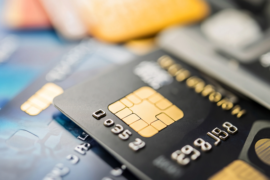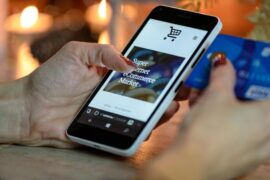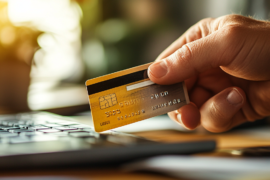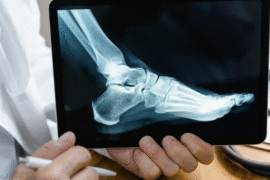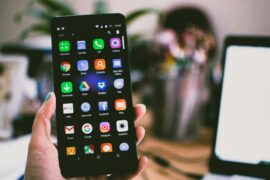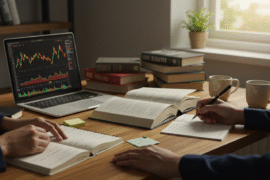This article may contain references to products or services from one or more of our advertisers or partners. We may receive compensation when you click on links to those products or services. Nonetheless, our opinions are our own.
The information presented in this article is accurate to the best of our knowledge at the time of publication. However, information is subject to change, and no guarantees are made about the continued accuracy or completeness of this content after its publication date.
Main Points
- People buy things on a whim because of who they are and things around them, like how they feel or what is happening at the time.
- Consumer research shows that people often buy things suddenly because of what others think and their feelings.
- Things like acting on impulse and feeling excited push people to buy on the spot.
- Online shopping sites have made it easier for people to buy things they did not plan to, so now these kinds of buys happen more often.
- Learning about why people buy the way they do helps us and companies know how to deal with sudden buying urges.
- Marketers use ways to make people buy on impulse, both in stores and on the internet.
Introduction
What makes people buy things on impulse such an interesting topic in consumer psychology? This happens because people shop in many different ways and make choices for many reasons. Impulse buying means people make quick and unplanned purchases. These choices are often emotional and feel urgent. When we look at why people do this, it helps marketers and researchers learn more about customers. By studying what types of people and situations lead to these buying habits, experts can better understand and change how we look at shopping actions.
Impulsive Buying Tendencies

Impulsive buying habits are about the want to buy things you did not plan for. This often happens all of a sudden. These habits come out in ways that show what people feel and think and how their bodies react. A mix of how people feel and what makes them buy leads to such unplanned shopping. People often buy items right away to feel good or because of what is around them in the moment. When we look at why people do this, we can understand more about human behavior.
People are all different, and this helps us learn more about why some of us buy things without planning. Things like what is going on around us and pressure from others mix with the way we each see things. This mix helps show us why sometimes we buy things on a whim and do not plan.
What Is Impulsive Buying
Impulsive buying is when people buy things without planning or thinking about it first. It happens right away and is not something they expect. People often do this because they want to feel good fast or make themselves happy in the moment.
Impulse purchases usually happen because of strong urges. These come from things in your mind and around you. Your feelings have a big role in this. They make you feel like you have to buy it right now. People often decide to buy fast, without thinking about it much. New things and shiny products also pull them in.
Consumer behavior here is more than just about being practical. People buy on a whim when the product feels right or when a special deal makes it too hard to pass up. These quick decisions feel good at the time, but later, the person may feel sorry for what they bought. This shows how strong feelings can shape the way we shop in stores or online.
Common Signs Of Impulse Purchases
Impulse shopping can show up in many ways. You can spot this kind of buying by looking for these signs:
- Unplanned purchasing: Getting things that were not on your list when you went shopping.
- Emotional triggers: Buying something because you feel stress, excitement, or your mood goes up.
- Quick choices: Buying things without stopping to think too much about it.
- After-buying regret: Feeling sorry or unsure about what you got after you bought it right away.
- Buying with discounts: Getting things because there is a sale or a special offer, even if you did not plan to get it.
These signs show that things around you and your feelings inside are very important when you buy on a whim. Noticing these patterns can help you have more say over what you buy and spot what makes you spend money.
Personality And Its Link To Impulse Buying
How does who you are connect with quick buying? The way people act and feel has a big impact on why they buy things without thinking. Things like acting on impulse and showing feelings strongly let people make these quick shopping choices.
Studies about buyers show that when people feel strong emotions, they may be more likely to make quick buying decisions. People who like to take risks or who find it hard to stop themselves show that the way you act can change what you buy. By looking at this, experts want to find out more about why people feel the need to buy things.
Personality Traits That Influence Impulsive Buying
The link between buying things on a whim and the way people act is important. These traits usually help shape how people shop and what they buy. Here is an easy-to-read look at some main traits:
| Trait | Description |
|---|---|
| Impulsivity | The inability to resist buying when emotionally driven or seeing attractive items. |
| Arousal-Seeking | A preference for experiences that generate excitement or high stimulation. |
| Overconfidence | A tendency to believe that impulsive choices will lead to positive outcomes. |
| Risk-Taking | A tendency to act boldly, including making impulse purchases. |
These traits can help show what people will do when they buy things. This lets marketers make plans that use how likely people are to act on impulse.
How Emotions Lead To Sudden Buys
Emotions have a strong effect on how people buy things without planning. How excited or calm someone feels can shape if they want to get things that were not on their list. When excitement is high, people often feel more pushed to buy quickly and without much thought. This means they might get something without thinking about it much first.
Feelings like happiness or stress can make people buy things without much thought. When you feel good, you may be more likely to buy things on the spot. When you feel bad, like when you feel sad, you might go shopping to feel better.
When marketers know these emotional triggers, they can make campaigns that go after what people feel. Things like limited-time deals, saying a product is guilt-free, and catchy ads are ways they use these feelings.
Voted "Best Overall Budgeting App" by Forbes and WSJ
Monarch Money helps you budget, track spending, set goals, and plan your financial future—all in one app.
Get 50% OFF your first year with code MONARCHVIP
What Shapes Impulsive Buying Behavior
Impulsive buying happens because of things inside and outside a person. The way a store looks, sounds, or feels can make someone want to buy things without planning to. What is going on around you, like the time of year, also matters for this. At the same time, people around you and how you feel right now can push you to shop when you did not plan to. Things like friends’ opinions or strong feelings can make you get things done on the spot.
These close links between how people feel and what is around them help us better understand consumer research. Looking into these things shows us why many people act on impulse when shopping now.
Social things and things around us can lead to people acting without thinking. Some main things that set this off are:
- Peer impact: Shopping with friends can make people buy things they did not plan to get. This happens because of how the group acts together.
- Product displays: Nice-looking setups in a store can make what is for sale look better. This can also make people want to buy things quickly, without thinking much.
- Sales by season: Times like holidays or big offers for a short time can make people shop without planning.
- Easy shopping: When it is simple to buy with things like one-click pay, people are more likely to buy things online without thinking too much.
Retail spaces and talking to others can help people feel close to products. This can make people act without planning. Marketers use these things to help boost sales.
Psychological And Emotional Triggers
Knowing how people feel is important when trying to understand why they buy things. A boost in mood or feeling stressed can quickly change what people choose to buy. For example, strong feelings can make people buy things without planning, just to feel better right away.
Things like decision fatigue are also very important. When you feel tired from thinking too much, you may be more likely to make quick choices and buy things you want but do not need. This makes it easier to just go along with buying something without thinking a lot. Ads or even the way something is packed can stir up feelings that make you act this way.
Knowing how your feelings and thoughts come together can help you deal with your quick actions better.
How To Recognize And Manage Impulse Buying
If you are new to spotting and handling the need to buy things on the spot, consumer psychology can help you. Start by looking at how much you can control these feelings. Think about if these habits come from things in your mind or the world around you. Do you see that this need to buy now is bad for the way you shop?
With new research and more people knowing about this now, you can look at what sets you off or what is going on around you. Shopping and spending time with friends can often make you more likely to buy things on impulse. If you learn how to handle these moments, you can turn those spur-of-the-moment purchases into smart choices.
What You’ll Need To Begin
To start to manage impulsive buying, get the right tools and ways to help you.
- Tracking apps: Use spending trackers so you can see right away when you buy something you did not plan for.
- Budget planning tools: Set spending limits to help set clear lines you will not cross.
- Consumer psychology knowledge: Try to learn more about why you feel the way you do when you shop.
- Research-backed methods: Look at studies and reviews to get more answers and ideas.
- Supportive community: Getting help and advice from others can stop you from shopping in a rush.
These tools help you get ready to deal with sudden buying habits and help you take charge of your money again.
Common Challenges For Starters
Managing acting without thinking much when shopping can be hard. Here are some common problems you might face:
- Emotional resistance: It can be hard to stop yourself from buying things when you feel certain moods.
- Tracking inconsistencies: Not using tracking tools the right way can make it tough to move forward.
- Peer influence pressure: When you shop with your friends, you might end up buying things just because they do.
- Knowledge gaps: Not knowing enough about why people shop can waste time and money.
Facing these problems takes time and being calm. If you stay up to date, you can slowly get better at handling your impulses.
Steps To Manage Impulse Shopping
A clear plan can help you handle buying things on impulse. Start by knowing what makes you want to shop and see the times you usually spend money. Use this information with steps to set limits for yourself and try using apps to track your spending. This can help you get better at stopping yourself from impulse shopping.
1. Identify Your Impulse Triggers
Start by finding out what makes you feel like buying something on impulse. This can be your feelings or things going on around you when you shop. Watch how different places, like online shops, physical stores, or time with other people, change what you do.
Take note of how you use your money. This will help you find patterns. Write down what you buy without planning and how you feel when you do it. This can show you why you spend the way you do. When you know these things, it will be easier for you to work on them.
2. Assess Your Shopping Patterns
Look at your shopping habits to find out if you buy things without much thought. Think about how you act when you shop each week or month. Do you often buy things that are not on your list? Do these unplanned buys usually happen at certain times or when you feel a certain way?
Use things like bank statements or money apps to get feedback on your spending. Consumer behavior studies say that when you track your spending, you get good ideas about your habits. This can help you understand why you sometimes buy things on impulse and find ways to improve.
3. Set Realistic Boundaries And Goals
Set some limits to help stop shopping without thinking. You can do this by making clear spending limits for buying things online and in stores. You can also pick spots in stores where you know you will not buy extra things.
Set goals you can work on and change if you need to, like keeping impulse spending at 10% of your usual budget. Giving yourself small rewards when you follow your own rules can help you build good habits.
4. Use Tools To Track Your Spending
Use tools to keep an eye on quick buys. Platforms that use the technology acceptance model are good for seeing how you spend money right when it happens.
Budgeting apps and online trackers come with tools that help you see when you make quick shopping decisions. Some apps will send you a message if you are about to buy more than you planned. This can help you stay on track with your money goals.
Final Thoughts
To sum up, knowing about impulsive buying is important. It helps you see how your feelings and way of being shape the way you shop. When you find out what makes you want to buy things quickly, you can set real plans to stop yourself. This will help you get better with money and make smarter choices about what you buy. Getting better at this does not happen fast. It takes time, self-knowledge, and steady effort. Try the tips given earlier to start making better choices. If you want to be better at handling money, you can talk to people who know more and can help you along the way.
Frequently Asked Questions
Can impulsive buying be completely stopped?
Impulsive buying cannot be fully stopped, but it can be cut down a lot. You can control this better by knowing what leads you to make these choices. Studying the way people buy things helps get a handle on sudden shopping urges.
Who is most likely to buy on impulse?
People who act without thinking or feel strong emotions can fall for impulse buying more often. Studies say people who feel too sure about their choices or take more risks will also buy things without planning.
Are there easy ways to buy less on the internet without thinking?
Yes, using spending trackers, turning off shopping app alerts, and making a wishlist so you do not buy right away all help. Also, knowing a bit about how ads work and why you want to buy things right away can help you not making quick buys online.
How can I see if I need to buy something or if I am just acting on impulse?
A buy that you needed was planned before and helps you with a real need. An impulse buy is one you feel like making suddenly, and is filled with emotion. Watch your habits and think about why you feel like buying to see what you need, and when you may buy just because of a feeling or an ad.

Reviewed and edited by Albert Fang.
See a typo or want to suggest an edit/revision to the content? Use the contact us form to provide feedback.
At FangWallet, we value editorial integrity and open collaboration in curating quality content for readers to enjoy. Much appreciated for the assist.
Did you like our article and find it insightful? We encourage sharing the article link with family and friends to benefit as well - better yet, sharing on social media. Thank you for the support! 🍉
Article Title: Impulsive Buying Tendencies and Personality
https://fangwallet.com/2025/06/26/impulsive-buying-tendencies-and-personality/The FangWallet Promise
FangWallet is an editorially independent resource - founded on breaking down challenging financial concepts for anyone to understand since 2014. While we adhere to editorial integrity, note that this post may contain references to products from our partners.
The FangWallet promise is always to have your best interest in mind and be transparent and honest about the financial picture.
Become an Insider

Subscribe to get a free daily budget planner printable to help get your money on track!
Make passive money the right way. No spam.
Editorial Disclaimer: The editorial content on this page is not provided by any of the companies mentioned. The opinions expressed here are the author's alone.
The content of this website is for informational purposes only and does not represent investment advice, or an offer or solicitation to buy or sell any security, investment, or product. Investors are encouraged to do their own due diligence, and, if necessary, consult professional advising before making any investment decisions. Investing involves a high degree of risk, and financial losses may occur including the potential loss of principal.
Source Citation References:
+ Inspo
There are no additional citations or references to note for this article at this time.










